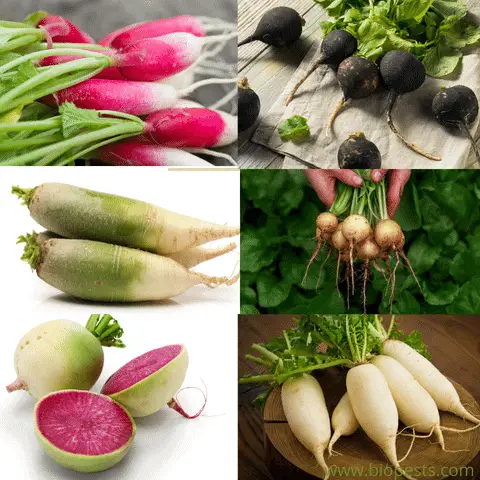Those who like spicy food sometimes wonder which foods to try next; today, we are testing radishes. Which radishes are the more pungent? We want to gather as many radishes as possible, or at least as many radishes as we can find, and evaluate their spiciness.
Radishes belong to the same family as mustard and horseradish. All of them contain specific compounds that, when combined, yield allyl isothiocyanate. Allyl isothiocyanate evaporates over time and is water soluble. Therefore, washing a chopped radish or leaving it exposed will lose its spicy flavor.
We will scour the internet to find information on what makes radishes spicy and then list the number of radishes we found and how hot they are.
What Makes Radishes Spicy
Radishes have a spicy taste, even though they don’t have the same taste compounds as chili peppers. Instead, when you bite them, radish has a compound that creates sulfur, making it taste spicy.
Although they are not particularly potent or hot, they contain the same chemical that gives mustard, horseradish, and wasabi their heat. (By the way… Don’t confuse radishes with horseradish! Here is an article that explains the difference between the two)
So although some farmers claim that radishes cultivated in hotter climates are spicier than those grown in cooler temperatures, this is not a firm rule.
Different Uses For Radishes
Even novice gardeners can quickly grow radishes. Radishes are available in various hues, from white to red to black. They can weigh several pounds and come in multiple shapes, from icicles to circular bulbs. One unusual Asian species has green meat and red skin. Unfortunately, we’ve ignored them even though they’ve been on produce shelves for years.
A hollow red radish occasionally finds its way into our tray of raw vegetables. But, there aren’t as wide varieties to choose from at our local produce store. It’s unfortunate because radishes are good for you and have a lot of advantages. Raw, sautéed in butter, blended in soup, and sliced in pickles—all of these preparations are excellent options.
They are perfect for dieters as flavor enhancers in various foods because they combine spice, crunch, and low-calorie content. Grilled fish, potatoes, cabbage, carrots, and radishes go well with fresh bread and butter, slice and serve. Have you ever tasted a sandwich made from them?
How Many Varieties Of Radishes Are There
There are more than 25 varieties of radishes which account for roughly 2% of global vegetable production, with approximately seven million tons produced yearly. Americans consume 400 million pounds (2000 tons) of radishes in a single year. We are lightweights compared to other countries.
Black Spanish Radishes
Black Spanish radishes are round, with coal-black skins and pure white flesh. Black radish is a large root crop that grows to the size of a turnip and is thought to have originated in Asia. It is believed to arouse bile production and thus aid digestion when eaten as a medicinal root rather than a food. Black radishes have a sharp, spicy flavor reminiscent of horseradish and can be used raw or cooked.
It is generally agreed that the black Spanish radish is the variant with the most heat, but you will need to judge whether you find it hot enough for your preferences.
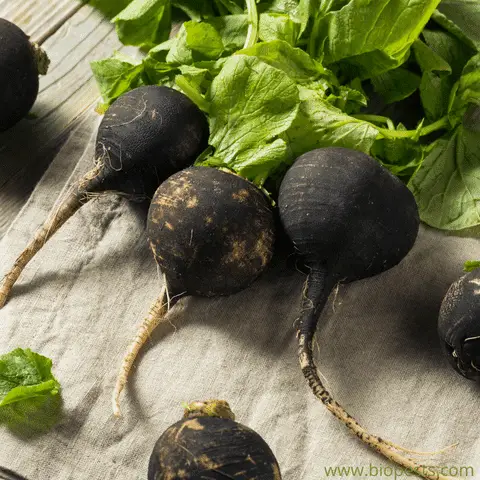
Cherry Belle Radish
Cherry Belle radishes are 1” in diameter and bright cherry red, with 2.5 – 3 inch tops. Crisp, firm, and white flesh. It keeps well and can get planted throughout the summer. The Cherry Belle Radish is a fast maturing, early-season radish that is best used raw in salads and condiments.
Cherry Belle radish is typically ready to harvest in about 3 1/2 weeks from seed sowing. Cherry Belle is a popular moderately spicy variety that is tolerant of problematic soils and somewhat tolerant to heat.
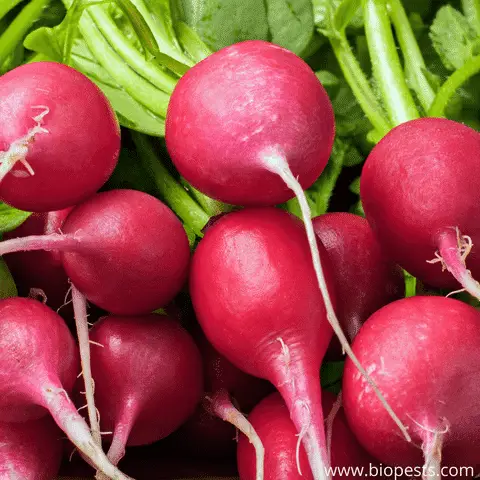
China Rose Radish
The China Rose is a very hardy variety that can be grown yearly. They came from China and quickly spread to Europe and the Mediterranean. The radish ‘China Rose’ is one of the oldest radish, introduced to Europe around 1850 by Jesuit missionaries.
They are described as having “firm flesh” and “excellent for winter use.” It has a delicious rose color and peppery undertones. Plant in late summer for harvest; once the weather cools, they can be lifted and stored in very cool (33°F) and humid conditions.
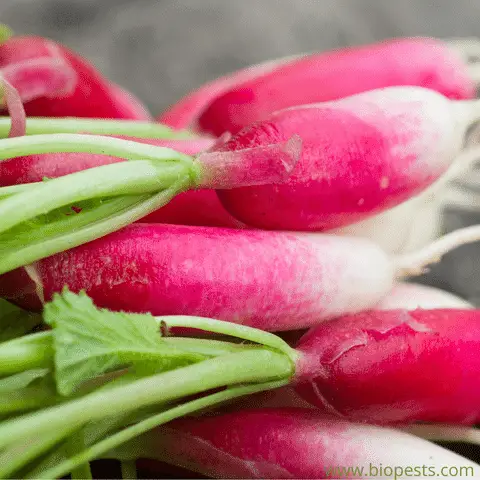
The Perfecto Radish
This radish is a bright and vibrant red color with white flesh and is commonly mistaken for the Cherry Belle radish, but unlike the cherry belle, the Perfecto Radish has a more peppery taste. The Perfecto Radish is sweet, spicy, and crunchy.
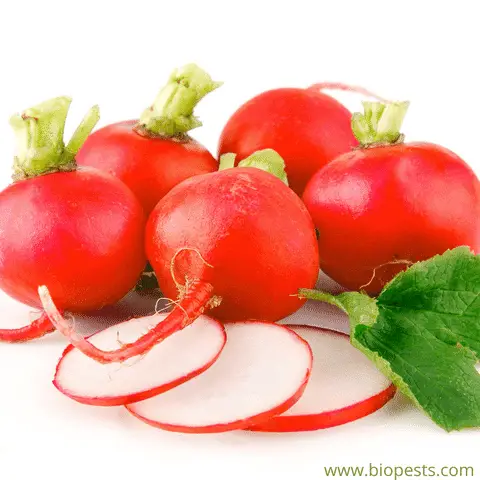
Chinese Shawo Fruit Radish
The Chinese Shawo Fruit Radish is unique with its bright-green color that can be found inside and outside the radish. It originated in North China and frequently gets served thinly sliced at tea parties in places like Beijing.
The roots are crisp and sweet, making them a tasty fruit substitute with a texture and flavor similar to a pear. Northern Chinese winters are notoriously harsh, perfect for these radishes because when exposed to frost, these long cylindrical radishes sweeten and make a nutritious mid-winter snack.

The Zlata Radish
These radishes are the color of “gold,” which is what the Russian word Zlata means. They grow pretty quickly and often mature in about 30 days. They are smooth and slightly peppery. Radishes from Zlata are offered from the spring to the beginning of the fall.
Small to medium-sized Zlata radishes have a consistent round to oval shape, measure around 2 inches in diameter, and have a single, extended fleshy taproot. The radish’s skin varies in color from yellow to tan to golden-brown and is thin, semi-smooth with some roughness, and taut. The white meat is firm, dense, watery, and crisp beneath the skin, with a crunchy, snappy quality.
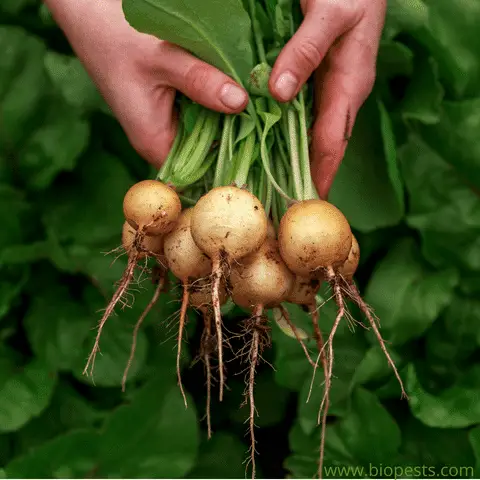
White Icicle Radish
The White Icicle radish is an elongated vegetable that may grow up to eight inches long. It is bright white and has a strong flavor. In mild climates, icicle radishes are often available all year long, with the spring and summer being their prime seasons.
White Icicle radishes have thin-skinned, 6” long roots tapered like carrots. This ancestral radish species is perfect for salads or garnishes since it is crisp and tender with a rich and peppery flavor. It matures in around 28 days.
The uniform roots are smooth, bright white, firm, and thin on the outside, with a few taproot hairs occasionally emerging from the base of the radish. When the top of the root is exposed above the soil and not shielded from sunlight, icicle radishes may also produce green shoulders. The flesh is solid, white, and watery behind the skin and has a crisp, snappy quality.
The texture of the cooked roots softens and becomes delicate, while the spicy overtones mellow and intensify to become a neutral, sweet, and savory flavor. Icicle radishes also produce edible leafy greens with vegetal, grassy, mildly spicy flavor and roots.
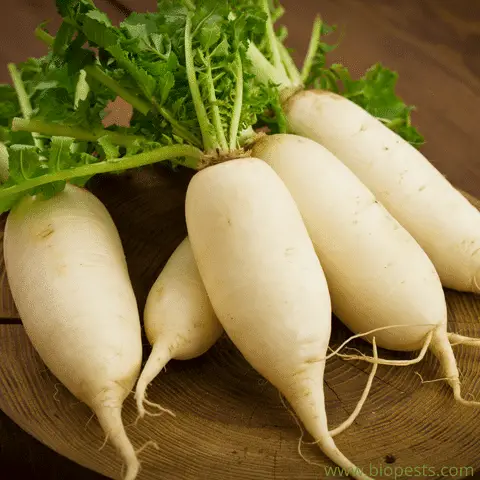
Chinese Green Luobo Radish
The Chinese Green Luobo radishes, also known as Qinluobo radishes, are an heirloom variety with lime-green skin and flesh. This radish stores well, it is spicy and is best eaten pickled or cooked. Biennial radishes require cold temperatures to flower and produce seeds, so grow them to maturity in the fall.
Chinese Red Meat Radish
The colorful “Beauty Heart” radish from ancient China has 4-inch round roots with white-and-green skin, but the magic is in its rose-red center, which is sweet, crisp, and delicious. The Chinese Red Meat radish is one of the mildest radishes, with only a slight peppery bite. These are sweet and flavorful when harvested in the late fall or early winter, almost like a crisp fruit.
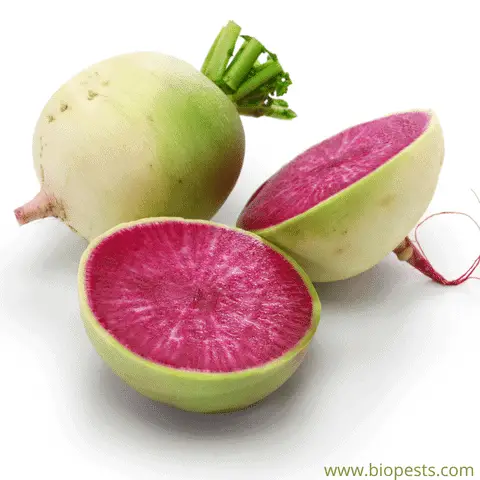
Does The Size Of The Radish Make It Spicier?
There is a common miss conception that the bigger the radish, the more pungent and spicier it is, which is understandable but isn’t entirely true. Instead, it is more to do with the age of the radish and how long you leave it in the ground. The longer your radish stays in the ground, the more allyl isothiocyanate gets produced. These compounds are responsible for the vegetable’s characteristically fiery flavor, which it will be able to create when left for longer.
Can You Make Radishes Spicier?
Some farmers say the temperature you grow your radishes in also plays a significant role in how spicy the radish is. Growing your radishes in hot, dry areas and giving them minimal water will produce a hotter radish. The best way to eat your radish is raw and unpeeled because the skin contains the most allyl isothiocyanate, responsible for the spicy, pungent taste of horseradish mustard and wasabi.
Sometimes things don’t go as planned and radishes happen to have a bad “soil taste” instead. This depends on many factors as I explain in this article.
How To Make Radishes Less Spicy
The peel contains most compounds that cause the sulfur-like reaction and gives radishes their spicy flavor. Peeling the skin is the first method for removing the spiciness. When leaving the exposed radish in the air will essentially evaporate the spiciness.
The second method is to soak them in chilled ice water. So take your radish, score it slightly, add it to some ice water, and then chill the ice water for at least an hour. It will also help to reduce the spiciness. It is not, however, as effective as peeling it.
The final step is to roast the radish. You can avoid peeling the radish by roasting it. You can toss the radish with olive oil, place them on a baking sheet, and roast them in the oven. Roasting them will also remove all bitterness. So it’s pretty tasty but also a little more work.
Conclusion
There is no accurate measurement for comparing the spiciness of radishes. Each variety has its own unique taste and texture, and the spiciness depends on the time of year, heat, how long it was in the ground, and eating them straight after they are cut open. Therefore you will find the same type of radish will vary significantly in spiciness.
If you are a radishes lover, check out these articles!
Why Radishes Get Worms? Tips On How To Solve This Problem
Radish Vs. Horseradish. What’s The Difference?
Why Do Radishes Taste Like Soil? Here Is Why
Some of the links above are affiliate links, meaning, at no additional cost to you, I will earn a commission if you click through and make a purchase.

